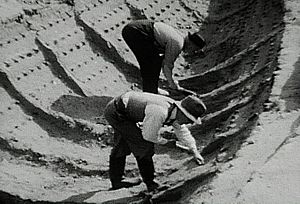Mercie Lack facts for kids
Quick facts for kids
Mercie Lack
|
|
|---|---|
| Born | 9 November 1894 |
| Died | 1985 (aged 90–91) |
| Occupation | School teacher, amateur photographer |
| Employer |
|
Mercie Kerr Lack (1894-1985) was a British teacher and photographer. She is best known for her amazing photographs of the Sutton Hoo discoveries in 1939. She took these pictures with her friend and fellow teacher, Barbara Wagstaff (1895-1974). Mercie Lack also took many photos of London street scenes.
Contents
Mercie Lack's Life
Mercie Lack was born in south London on November 9, 1894. She worked as a teacher for many years. Mercie and her friend Barbara Wagstaff both loved photography. They joined the Royal Photographic Society in 1944. They even earned a special award called an Associate that same year.
They both taught at Putney High School around 1935-1936. This fits with the time Mercie was taking photos of London. Mercie became a lifetime member of the Royal Photographic Society in 1949. She passed away in Stevenage in 1985.
London Photography
In the 1930s, Mercie Lack used special glass slides to capture scenes of London at night. These unique photos are now kept at the Museum of London. Some of her night-time pictures were shown in a special exhibition. It was called 'London Nights' and ran from May to November 2018.
Sutton Hoo Discoveries
In 1939, Mercie Lack and Barbara Wagstaff were on holiday in Suffolk. This was when the famous Sutton Hoo ship burial was found. They arrived after the amazing treasures had been taken out. But they were able to photograph the digging up of the ship itself.
People think they might have known someone at the British Museum. This person might have told them about the discovery. In 1936, there was a call for amateur photographers to help record archaeological sites. Mercie and Barbara were part of this effort. Their photos were much better quality than many others.
Photographing the Dig
Mercie and Barbara worked at Sutton Hoo from August 9 to August 24, 1939. They used Leica cameras. They also had a rare German 35mm Agfa colour film. This meant Sutton Hoo was one of the first digs in Britain to be photographed in colour!
Mercie took 297 black and white photos of the site. Barbara took 150. They each also took 36 colour pictures. Mercie even had a cine-camera. She filmed the archaeologist Basil Brown digging up the middle part of the ship. Another photographer took a picture showing Mercie and Barbara on either side of the ship.
Importance of the Photos
In 2010, about 400 prints of their Sutton Hoo photos were found. Mercie's great-nephew had given them to the National Trust. Before this, there were only 29 official photos from the British Museum.
During World War II, records of measurements from the Science Museum were lost. Mercie's detailed photos helped scientists rebuild a better picture of the dig. Many of her photos even had notes on them. In 2021, these photos were put online for everyone to see. Many of Mercie's photos and slides are also in the British Museum collection.
Mercie Lack was given some ship rivets by archaeologist Charles Phillips. She gave these rivets to the British Museum in her will. Mercie and Barbara's photos and film were used in a BBC show. It was called The Million Pound Grave and aired in 1965.
Exhibitions
Mercie Lack's photographs have been shown in several exhibitions:
- Captured on Camera: The Summer of 1939 at National Trust Sutton Hoo. This exhibition ran from November 23, 2010, to March 20, 2011.
- We Few People at National Trust Sutton Hoo. This show was about the people involved in the 1939 discovery and dig.
- London Nights at the Museum of London. This exhibition was open from May 11 to November 11, 2018.


